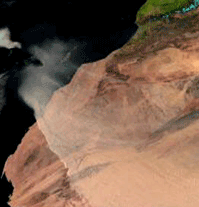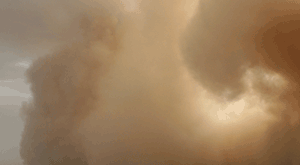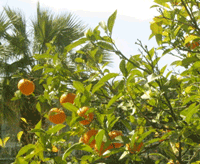Weather in the Languedoc-Roussillon in the South of France:
The Mediterranean Climate
The Mediterranean climate is one of hot summers and mild
winters. The name applies not only to the climate of the lands
bordering the Mediterranean
Sea, but a number of other land masses with similar climates.
Outside the Mediterranean this climate covers relatively
small areas of the Earth's surface, generally the western
coasts of continental land masses at latitudes around ±
35°. Regions that have a Mediterranean Climate include
much of California and non-coastal southern Oregon; the Western
Cape in South Africa; central Chile; the coastal areas of
central and south-east South Australia and the Southern part
of Western Australia (Perth has a typical Mediterranean climate).
  During
summer, regions of Mediterranean climate are dominated by
subtropical high pressure cells, with dry sinking air capping
a marine surface layer making rainfall
impossible except for occasional thunderstorms. In winter
the polar jet stream and its associated periodic storms reach
into the lower latitudes of the Mediterranean zones, bringing
rain (or snow at higher elevations). As a result, areas with
this climate receive almost all of its yearly rainfall
during the winter season, and may go up to 5 months during
the summer without seeing significant rain (Think Jean
de Florette). During
summer, regions of Mediterranean climate are dominated by
subtropical high pressure cells, with dry sinking air capping
a marine surface layer making rainfall
impossible except for occasional thunderstorms. In winter
the polar jet stream and its associated periodic storms reach
into the lower latitudes of the Mediterranean zones, bringing
rain (or snow at higher elevations). As a result, areas with
this climate receive almost all of its yearly rainfall
during the winter season, and may go up to 5 months during
the summer without seeing significant rain (Think Jean
de Florette).
Mediterranean climates tend to grade toward the poles into
zones of Oceanic climate in which summer rains are high, and
towards the poles into dry-summer steppe where winter rains
are low.
The Mediterranean climate is associated with the large subtropical
high pressure cells over the oceans. These high pressure cells
shift towards the poles in the summer and back towards the
equator in the winter, playing a major role in the formation
of the world's tropical deserts.
| Subtropical High Pressure
cell |
Associated Desert
|
Associated Mediterranean
Climate
|
| Azores High |
Sahara Desert
|
Mediterranean Basin
|
| South Atlantic High |
Namib Desert
|
Western Cape of South
Africa.
|
| North Pacific High |
Sonoran Desert
|
California
|
| South Pacific High |
Atacama Desert
|
Central Chile
|
| Indian Ocean High |
the deserts of western
Australia (Great Sandy Desert, Great Victoria Desert,
and Gibson Desert)
|
southwest and south-central
Australia.
|
All regions with Mediterranean climates have relatively mild
winters, but summer temperatures
depend on the region. All regions with a Mediterranean climate
are near large bodies of water, so temperatures are generally
moderate with a small range of temperatures between the winter
low and summer high.
    Temperatures
during winter only occasionally reach freezing and snow only
rarely occurs at sea level, but often in surrounding mountains.
In the Languedoc-Roussillon,
this means the Pyrenees,
the Massif Central and the Alps. In the summer, the temperatures
range from mild to very warm, depending on distance from the
open ocean and elevation. Strong winds from inland desert
regions can sometimes boost summer temperatures resulting
in a much increased risk of forest fire. In the Languedoc-Roussillon
the Scirocco
or Sirocco occasionally blows from the Sahara. Inland
locations sheltered from or distant from sea breezes can experience
severe heat during the summer. Temperatures
during winter only occasionally reach freezing and snow only
rarely occurs at sea level, but often in surrounding mountains.
In the Languedoc-Roussillon,
this means the Pyrenees,
the Massif Central and the Alps. In the summer, the temperatures
range from mild to very warm, depending on distance from the
open ocean and elevation. Strong winds from inland desert
regions can sometimes boost summer temperatures resulting
in a much increased risk of forest fire. In the Languedoc-Roussillon
the Scirocco
or Sirocco occasionally blows from the Sahara. Inland
locations sheltered from or distant from sea breezes can experience
severe heat during the summer.
  Locations
that are higher latitude and cut off from milder ocean winds
may have colder winters and more distinct seasons. This "temperate
Mediterranean" climate is most noticeable in the Languedoc
(and central Spain, northern Italy, and northern Greece).
In these areas, plants that are commonly associated with milder
Mediterranean climates, such as citrus, olive, oleander and
eucalyptus, will not survive a severe winter. You will see
orange and lemon trees near the coast of the Languedoc, but
not far inland. Locations
that are higher latitude and cut off from milder ocean winds
may have colder winters and more distinct seasons. This "temperate
Mediterranean" climate is most noticeable in the Languedoc
(and central Spain, northern Italy, and northern Greece).
In these areas, plants that are commonly associated with milder
Mediterranean climates, such as citrus, olive, oleander and
eucalyptus, will not survive a severe winter. You will see
orange and lemon trees near the coast of the Languedoc, but
not far inland.
Characteristic Mediterranean forests, woodlands, and shrubland
are closely associated with Mediterranean climate zones. Particularly
distinctive are sclerophyll shrublands called maquis in the
Mediterranean Basin - garrigue in the Languedoc (They have
different names elsewhere, chaparral in California,
matorral in Chile, fynbos in South Africa, and
mallee and kwongan shrublands in Australia).
The maquis provided a name for local guerilla fighters during
the Second
World War. They were known as the Maquis
from the wild areas in which they operated.
|

